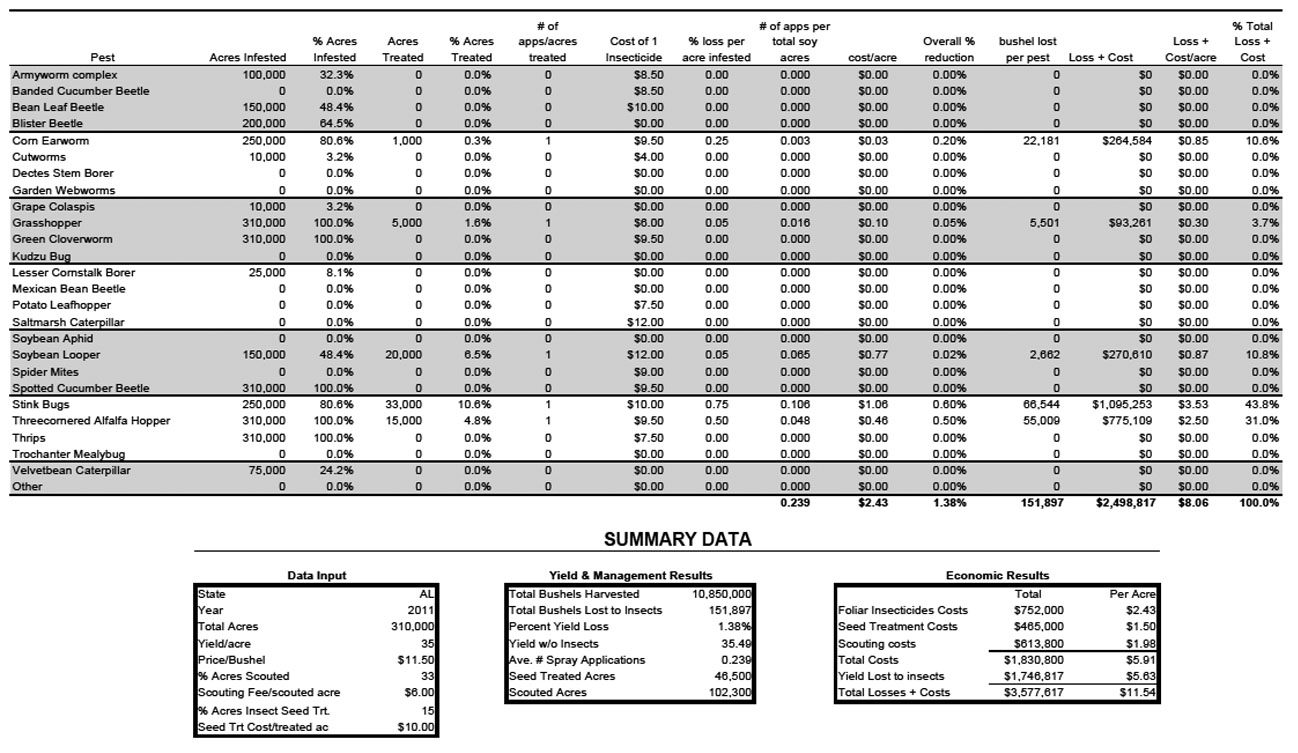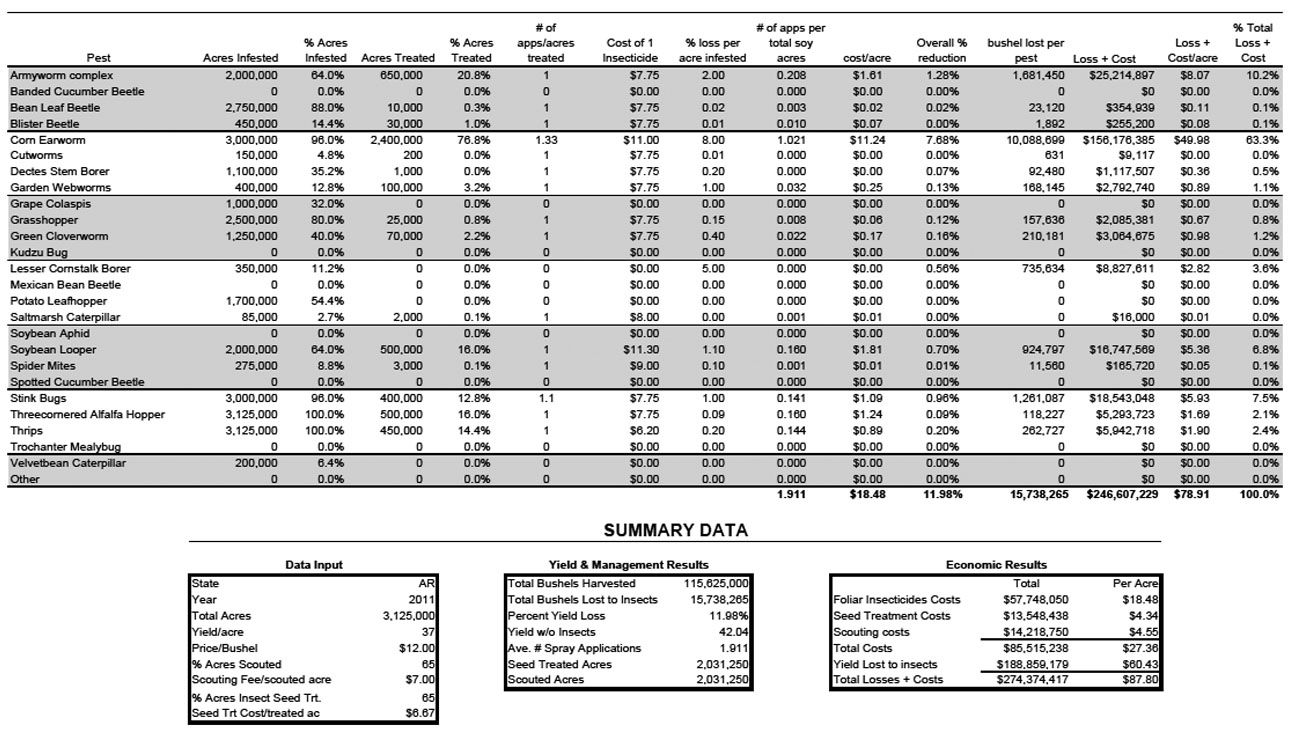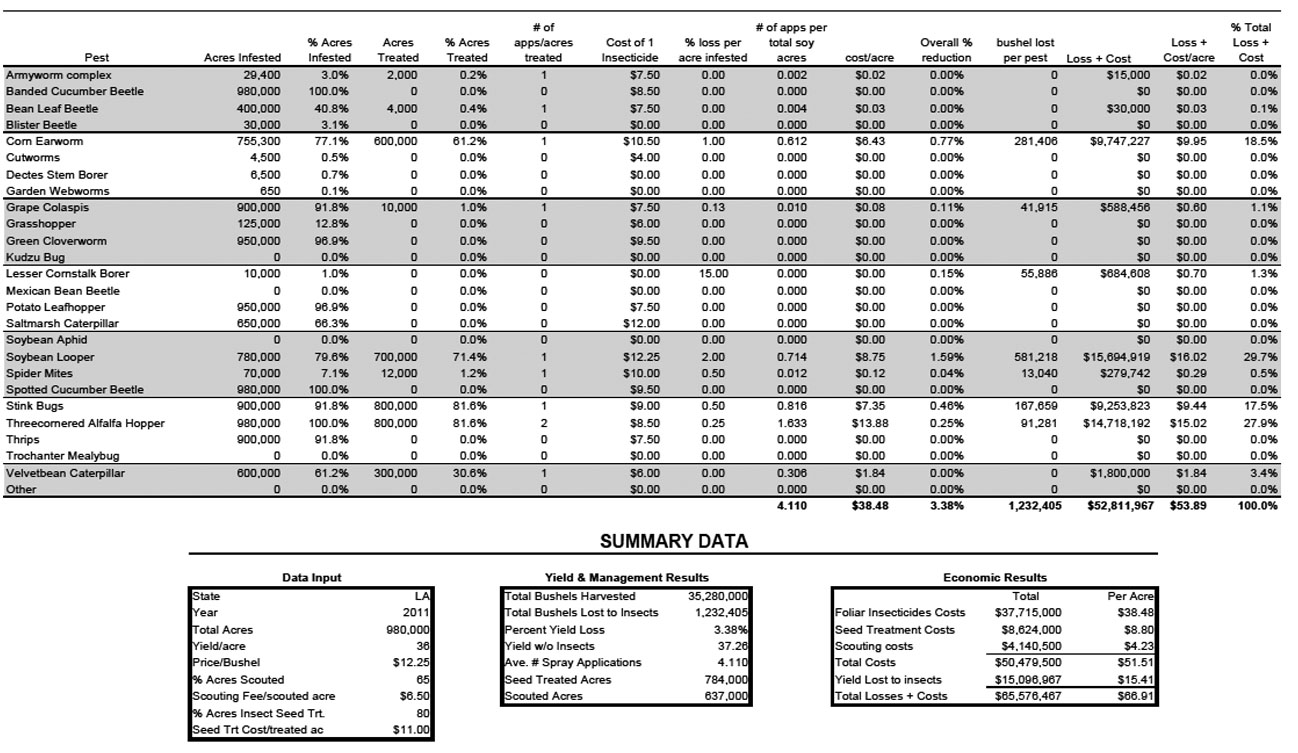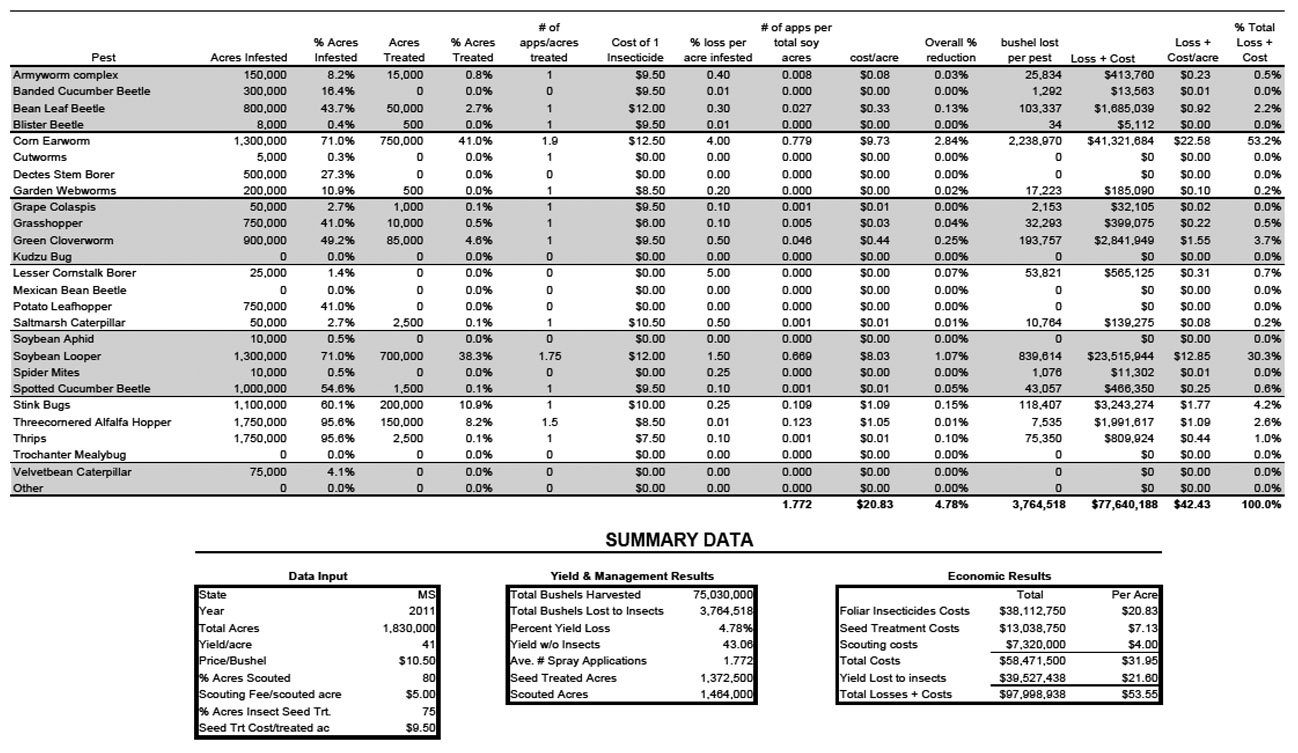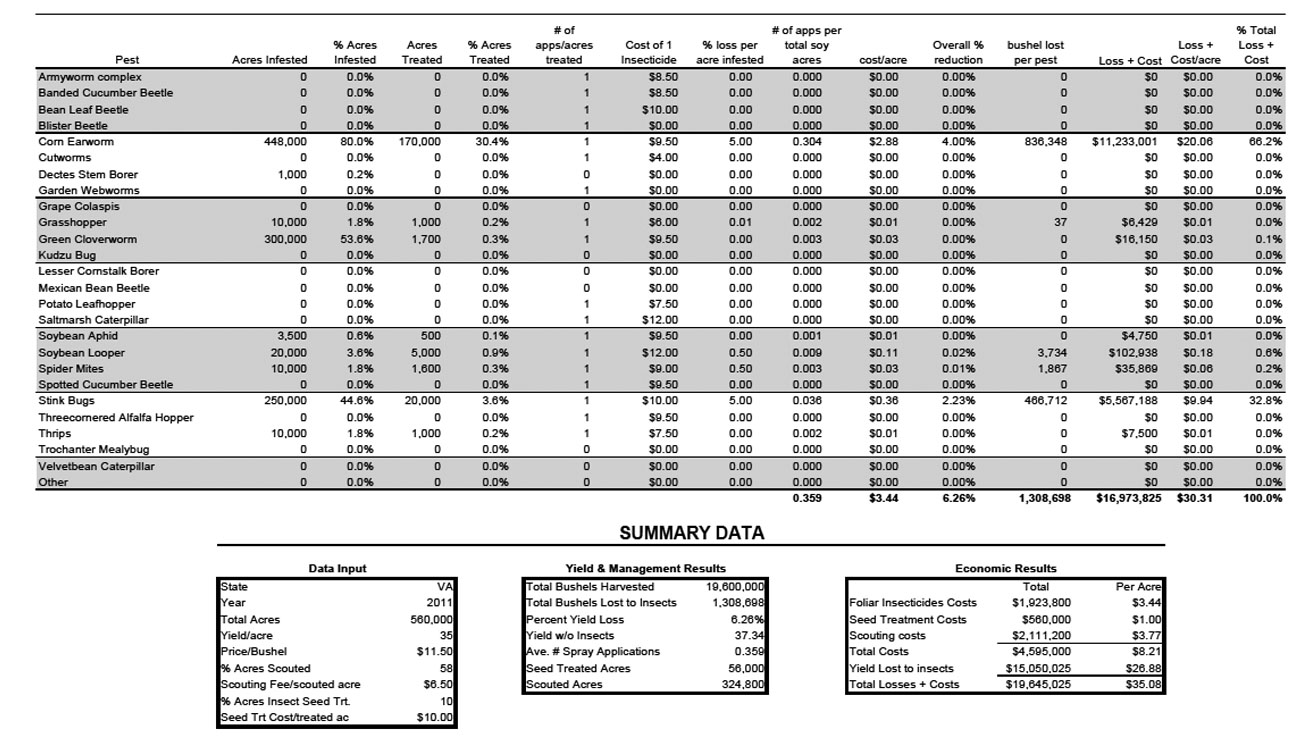Report
2011 Soybean Insect Losses in the Southern US [PDF]
Musser, F. R.*1, A. L. Catchot, Jr.1, J. A. Davis2, D. A. Herbert, Jr.3, B. R. Leonard4, G. M. Lorenz5, T. Reed6, D. D. Reisig7, and S. D. Stewart8
1 Mississippi State University, Department of Biochem., Mol. Biol., Entomol. and Plant Pathol., Box 9775, Mississippi State, MS 39762
2 Louisiana State University Agricultural Center, Department of Entomology, 404 Life Sciences Building, Baton Rouge, LA 70803
3 Virginia Tech, Tidewater Agricultural REC, 6321 Holland Rd., Suffolk, VA 23437
4Louisiana State University Agricultural Center, Northeast Region, 212 Macon Ridge Rd., Winnsboro, LA 71295
5University of Arkansas CES, Lonoke Extension Center, 2001 Highway 70 East, Lonoke, AR 72086
6Alabama CES, Tennessee Valley REC, 9494 Experimental Loop, Madison, AL 35756
7North Carolina State University, The Vernon James REC, 207 Research Station Rd., Plymouth, NC 27962
8 The University of Tennessee, WTREC, 605 Airways Blvd., Jackson TN 38301
*corresponding author email: fm61@msstate.edu
Received: 6-I-2012 Accepted: 12-I-2012
Abstract: Survey-based soybean insect losses provide a glimpse of current soybean management practices and allow one to see evolving trends. This survey was initiated in Mississippi in 2004, Tennessee in 2008, and Arkansas in 2009. The 2011 survey is the first to include Alabama, Louisiana, North Carolina, and Virginia. The 2011 survey represents nearly 9.5 million acres across the southern U.S. Overall, the 2011 survey shows corn earworm to be responsible for more than 50% of all insect-related costs and losses in the surveyed states. More than 50% of the acreage was scouted for a fee and more than 50% of the acreage was planted with a seed treatment. Estimated yield loss from insects was about 7.5%, or $33.93/acre. An additional $23.71/acre was spent on insect monitoring and protection, putting total insect losses plus costs at $57.64/acre during 2011, very similar to the $59.51/acre losses plus costs during 2010.Key Words: soybean, yield loss, pest management
Introduction
Soybean losses have been compiled annually since 2004 in Mississippi (Musser and Catchot 2008), 2008 in Tennessee (Musser et al. 2009), and 2009 in Arkansas (Musser et al. 2010), providing an annual record of insect pressure and management decisions. These estimates are based on surveys of consultants and extension personnel. A comparable survey is conducted annually in cotton across all U.S. cotton producing states (Williams 2010). While the costs and losses estimated for a pest in any given year are somewhat subjective, these losses provide an historical record of pest pressure and management practices and provide an estimate of the economic impact of the various soybean pests. Over time, the changes in estimated losses and insecticide applications provide a reliable record of shifts in pest spectra and grower management. The 2011 survey includes information from Alabama, Louisiana, North Carolina, and Virginia for the first time.
Materials and Methods
An informal telephone or written survey was conducted with numerous crop consultants and extension personnel in the fall of 2011. People who actively scouted soybean fields as well as those who assisted growers in making soybean pest management decisions were surveyed. These surveys were compiled and then combined with the author’s own experience to estimate the various fields in the table. Acreage, yield, and price data were drawn from Agricultural Statistics Service publications (USDA NASS) before final estimates were published, so values in the tables might differ slightly from final NASS values. The estimates were placed in an Excel spreadsheet (Microsoft Office 2010, Microsoft Corp.) to make the various calculations. The actual formulas used in the spreadsheet were published by Musser and Catchot (2008).
Results and Discussion
Management of soybeans continued to increase slowly in the mid-southern states as demonstrated by the percentage of soybeans that were scouted. The adoption of insecticide seed treatments in this region also continued to increase with at least 45% of soybeans planted with a seed treatment in each of the mid-southern states (Table 1). In contrast, insecticide seed treatments have not yet become widely adopted in the southeastern states, as Alabama, North Carolina, and Virginia only reported 15, 0, and 10% of acreage planted with a seed treatment, respectively. Of the states participating in the survey, the highest insect losses were found in Arkansas and the highest number of pesticide applications were made in Louisiana.
For the first time since this survey began, corn earworm, Helicoverpa zea (Lepidoptera: Noctuidae), was the most expensive insect pest overall in terms of lost yield and control costs, accounting for 55% of all insect costs plus losses. It was the most expensive pest in all states surveyed except Alabama (stink bug) and Louisiana (soybean looper). More than half of all soybeans were sprayed at least once for this pest during 2011. This continues a trend of increasing costs and losses associated with corn earworm observed in Mississippi since 2007 (Musser and Catchot 2008, Musser et al. 2009, Musser et al. 2010, 2011). The stink bug complex, which had been the number-one soybean pest in all other years, was not very damaging in 2011, accounting for less than 10% of insect costs plus losses. Other insects accounting for at least 4% of the insect losses included the soybean looper (Chrysodeixis includens, Lepidoptera: Noctuidae), the armyworm complex (Lepidoptera: Noctuidae), threecornered alfalfa hopper (Spissistilus festinus, Hemiptera: Membracidae), and lesser cornstalk borer (Elasmopalpus lignosellus, Lepidoptera: Pyralidae).
The 2011 survey was the first year losses were recorded for Megacopta cribraria (Hemiptera: Plataspidae), (in North Carolina) commonly known as the kudzu bug and for the trochanter mealybug, Pseudococcus sorghiellus (Hemiptera: Pseudococcidae) (in Tennessee). Both of these insects appear to be expanding their range and could become more important pests in the future.
A comparison of foliar insecticide applications during 2011 with previous years shows that the number of applications directed at corn earworm were up sharply in Mississippi, Arkansas, and Tennessee (Table 2). Applications for stink bug and bean leaf beetle control were down in all three states. The number of insecticide applications directed at other major pests was not much different from previous years.
The complete data for each state and all states combined are in the appendices following this report.
Table 1. Soybean management and losses in surveyed states, 2004–2011.
Table 2. Foliar insecticide use (number of applications per soybean acre) on major soybean pests past and present in Mississippi, Tennessee, and Arkansas.
References
Musser, F. R., and A. Catchot. 2008. Mississippi soybean insect losses. Midsouth Entomol. 1: 29-36.
Musser, F. R., S. D. Stewart, and A. L. Catchot, Jr. 2009. 2008 soybean insect losses for Mississippi and Tennessee. Midsouth Entomol. 2: 42-46.
Musser, F. R., G. M. Lorenz, S. D. Stewart, and A. L. Catchot, Jr. 2010. 2009 soybean insect losses for Mississippi, Tennessee, and Arkansas. Midsouth Entomol. 3: 48-54.
Musser, F. R., G. M. Lorenz, S. D. Stewart, and A. L. Catchot, Jr. 2011. 2010 soybean insect losses for Mississippi, Tennessee and Arkansas. Midsouth Entomol. 4: 22-28.
USDA NASS. NASS Data and Statistics, http://www.nass.usda.gov/Data_and_Statistics/Quick_Stats/
index.asp.
Williams, M. R. 2010. Cotton insect losses, http://www.entomology.msstate.edu/resources/tips/cotton-losses/data/ .
Appendix 1. Overall soybean insect losses from seven surveyed southern states, 2011.
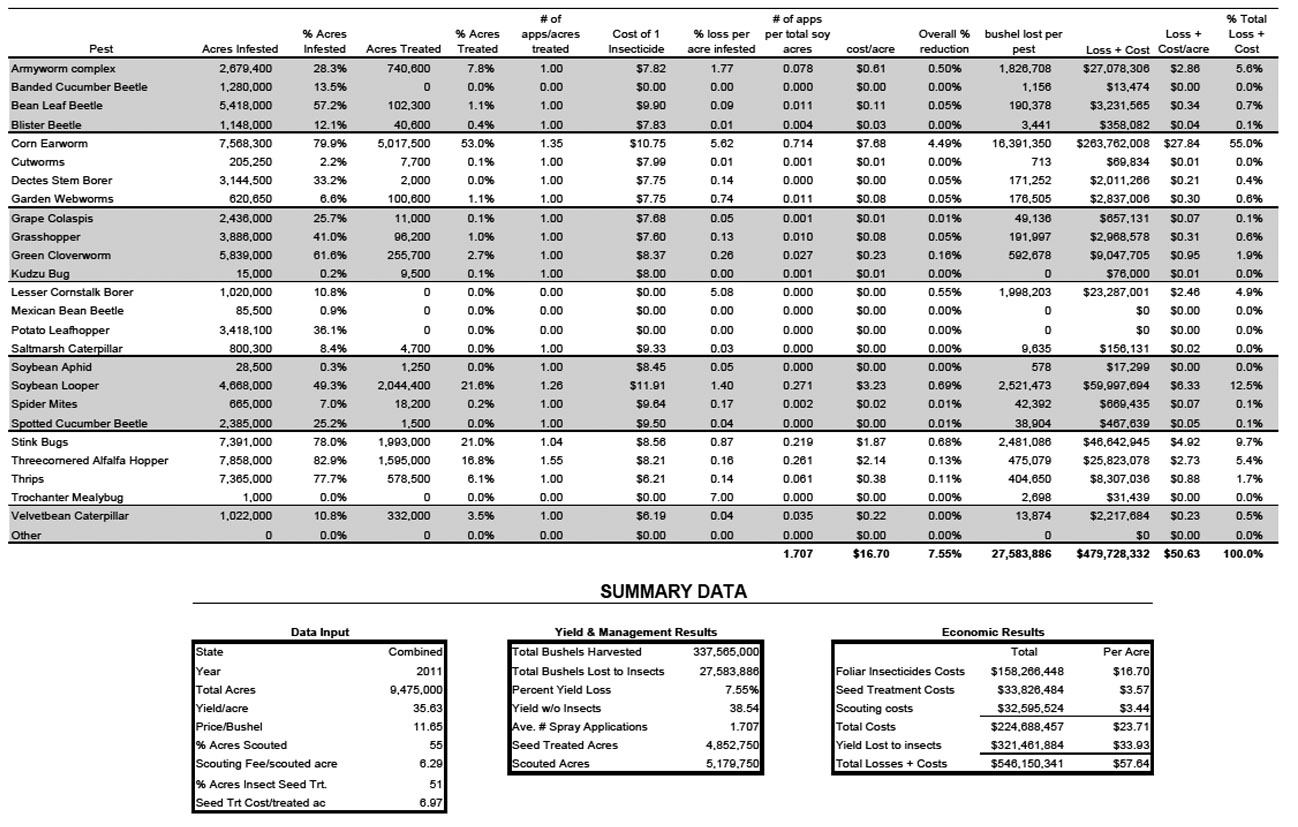
Appendix 2. Alabama soybean insect losses, 2011.
Appendix 3. Arkansas soybean insect losses, 2011.
Appendix 4. Louisiana soybean insect losses, 2011.
Appendix 5. Mississippi soybean insect losses, 2011.
Appendix 6. North Carolina soybean insect losses, 2011.
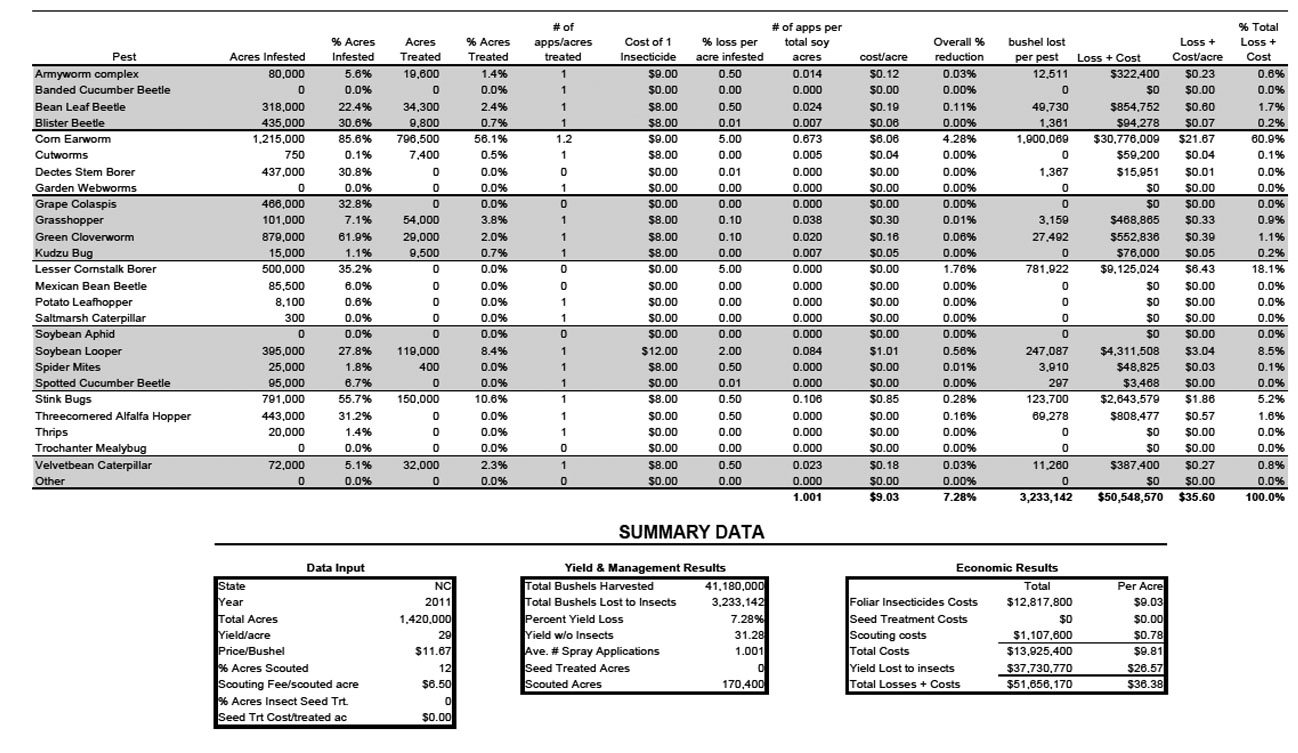
Appendix 7. Tennessee soybean insect losses, 2011.
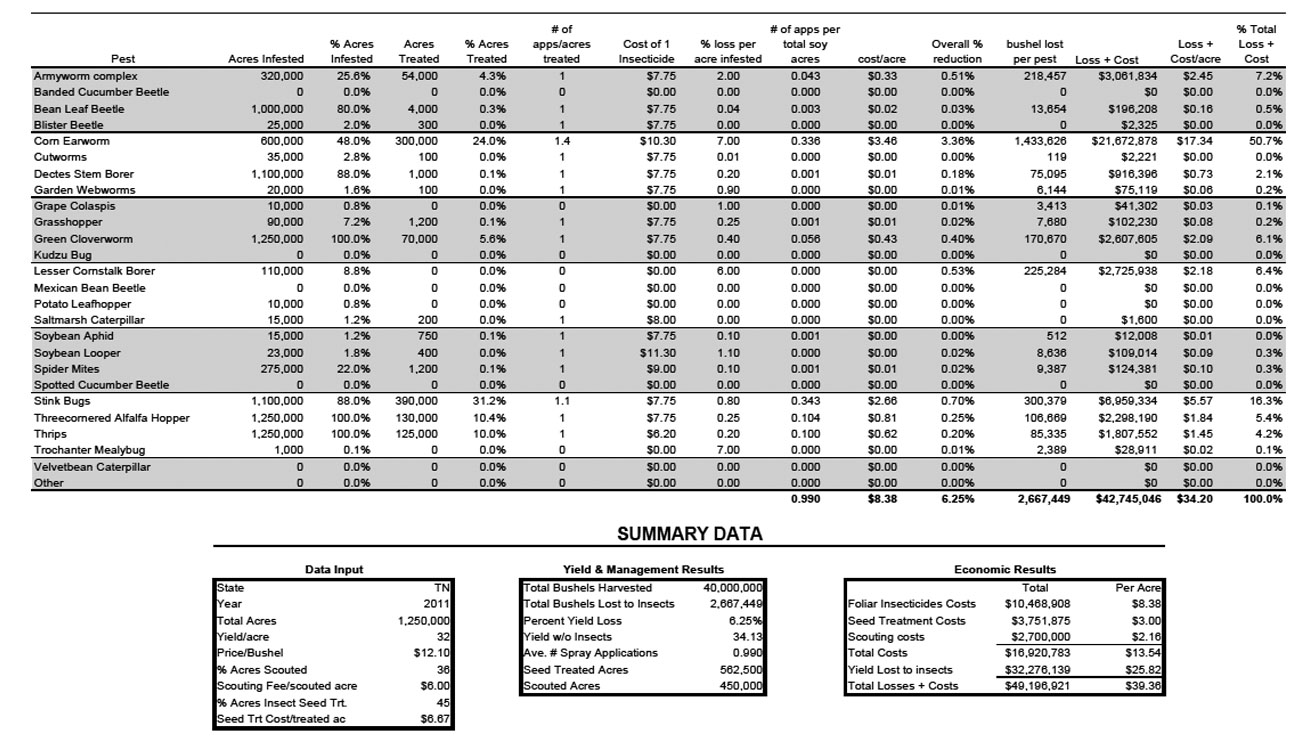
Appendix 8. Virginia soybean insect losses, 2011.



